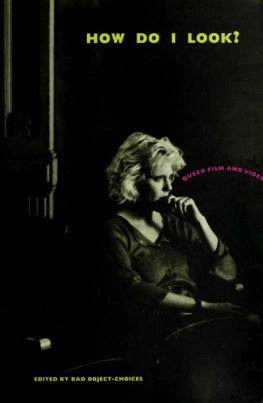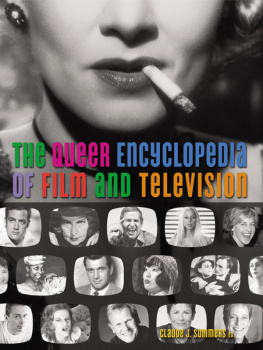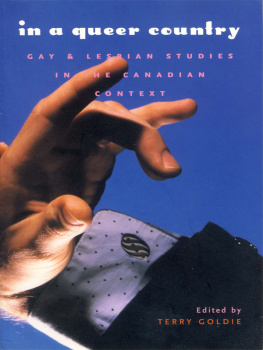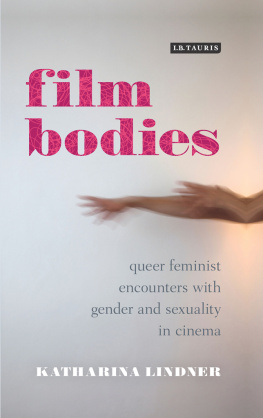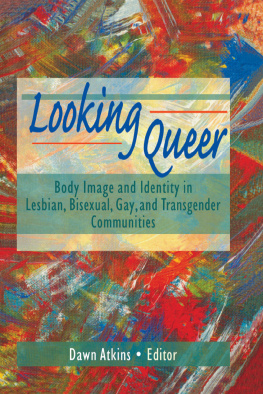Bad Object-Choices - How Do I Look? Queer Film and Video
Here you can read online Bad Object-Choices - How Do I Look? Queer Film and Video full text of the book (entire story) in english for free. Download pdf and epub, get meaning, cover and reviews about this ebook. year: 1991, publisher: Bay Press, genre: Romance novel. Description of the work, (preface) as well as reviews are available. Best literature library LitArk.com created for fans of good reading and offers a wide selection of genres:
Romance novel
Science fiction
Adventure
Detective
Science
History
Home and family
Prose
Art
Politics
Computer
Non-fiction
Religion
Business
Children
Humor
Choose a favorite category and find really read worthwhile books. Enjoy immersion in the world of imagination, feel the emotions of the characters or learn something new for yourself, make an fascinating discovery.
- Book:How Do I Look? Queer Film and Video
- Author:
- Publisher:Bay Press
- Genre:
- Year:1991
- Rating:5 / 5
- Favourites:Add to favourites
- Your mark:
- 100
- 1
- 2
- 3
- 4
- 5
How Do I Look? Queer Film and Video: summary, description and annotation
We offer to read an annotation, description, summary or preface (depends on what the author of the book "How Do I Look? Queer Film and Video" wrote himself). If you haven't found the necessary information about the book — write in the comments, we will try to find it.
How Do I Look? Queer Film and Video — read online for free the complete book (whole text) full work
Below is the text of the book, divided by pages. System saving the place of the last page read, allows you to conveniently read the book "How Do I Look? Queer Film and Video" online for free, without having to search again every time where you left off. Put a bookmark, and you can go to the page where you finished reading at any time.
Font size:
Interval:
Bookmark:

This book made available by the Internet Archive.
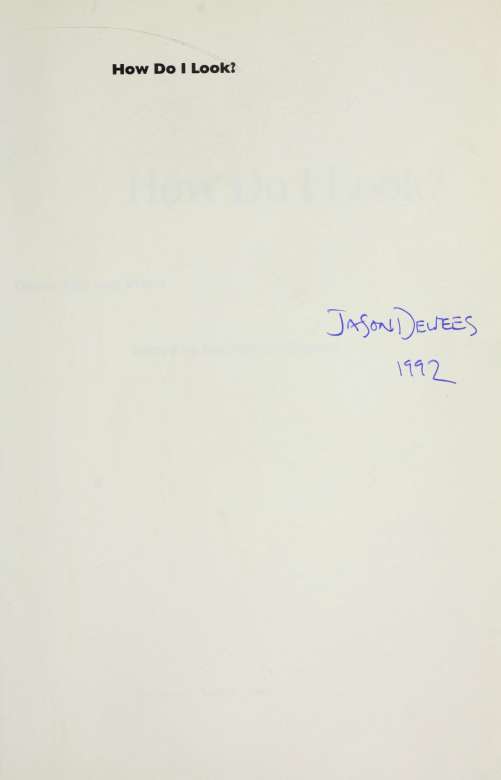
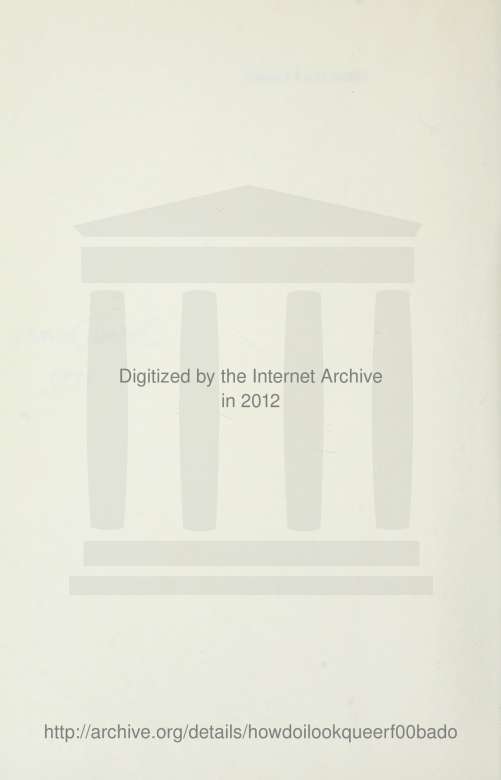

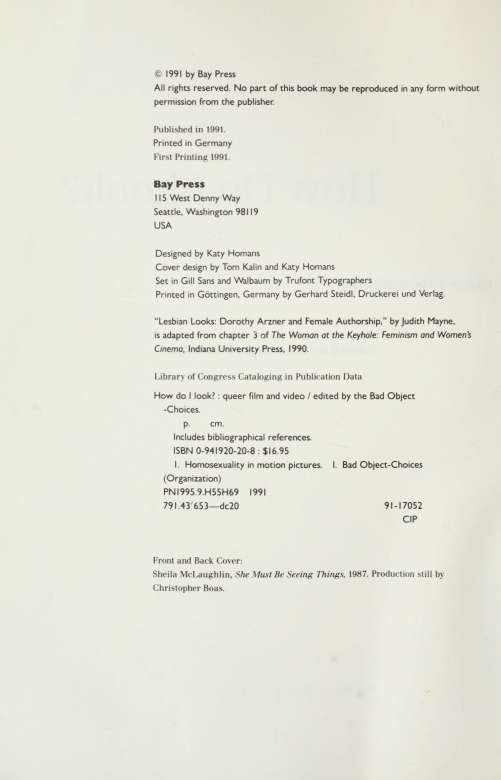
We dedicate this book to Vito Russo and Ray Navarro. Vito was a pioneer of queer film history. Ray, twenty years younger, had begun to make significant contributions to the theory and practice of lesbian and gay media. Vito and Ray died during the same week in the fall of 1990 after long battles with AIDS.

Preface and acknowledgments
The papers and discussions published here comprise the proceedings of a conference entitled "How Do I Look? Queer Film and Video," held at Anthology Film Archives in New York City, October 21-22, 1989. The six papers have been revised for publication by the authors. The follow-up discussions have been edited to focus on the most productive exchanges; in many cases, the presenters, in editing the discussions, have extended and added pertinent points to their answers. The editors of this volume are less interested in fidelity to the moment than in furthering the debates raised at the conference.
The "How Do I Look?" conference was organized by Bad Object-Choices, a reading group formed in the spring of 1987 to address questions of gay and lesbian theory. The conference proceedings were edited by the following group members: Terri Cafaro, Jean Carlomusto, Douglas Crimp, Martha Gever, Tom Kalin, and Jeff Nunokawa. Other members who helped organize the conference were Amber Hollibaugh, Timothy Landers, Eileen O'Neill, and Lee Quinby.
The conference was held in conjunction with a film and video series organized by Bill Horrigan and Martha Gever and sponsored by the Collective for Living Cinema in New York City. Our thanks to Jack Walsh and Nancy Graham, respectively past and present directors of the collective, for their assistance. Bill Horrigan devised the title "How Do I Look?" for the entire series of events. Jason Simon was responsible for recording the conference and, with the help of Moyra Davey, transcribing the discussions. Siochain Hughes helped with many organizational details.
The "How Do I Look?" screenings and conference were supported by a grant from the New York State Council on the Arts; the conference was additionally funded by the New York Council on the Humanities, which allowed us to bring a number
of film- and videomakers, critics, and theorists from Canada, England, and the West Coast to participate in discussions. Together with our six presenters, these informal discussants helped make the conference a success. Publication of the proceedings is supported by a separate grant from the New York State Council on the Arts. We wish to express our gratitude to the two state government granting agencies for so generously funding an avowedly queer event at a time when our federal government seeks to silence us.
Publisher's Note
The publication of this book was delayed two months as more than twenty printers refused to print or in many cases even bid on the project. At issue were images in the Patton, Mercer, and Fung essays.
I want to thank Cindy Peer at P. Chan & Edward for working so diligently to help us get this project on press. I also want to thank the editors and contributors for their patience and support. I am particularly grateful to Douglas Crimp for his good humor and outrage.
With the most generous support of Richard Serra and Clara Weyergraf we were able to have the book printed in Germany. We are indebted to their commitment to the project.
Introduction
Bad Object-Choices
When our reading group began planning the "How Do I Look?" conference in 1988, we didn't have a collective name, nor had we needed one. Two years earlier we had embarked on a project both simple and ambitious: to read and discuss texts related to the construction and representation of lesbian and gay subjects. We devised no program, but rather moved more or less at random from the writings of Michel Foucault to lesbian-feminist philosophy, from Freud to Freud's commentators and critics. We read recent work on identity, homophobia, AIDS, sex work, and lesbian sadomasochism. We also brought videotapes to meetings to view and discussvideos by lesbian and gay media makers and tapes about AIDS.
The idea for a conference on queer film and video emerged from the casual, nonlinear development of our group's interest in theoretical and political questions raised by lesbian and gay media. Or, rather, it arose from our frustration at the scarcity of work on this topic, a scarcity we knew resulted from a lack of institutional support from the academy and the publishing industry. We also knew that our interests were shared by many who make, distribute, and program lesbian and gay films and videos and by their audiences.
We came upon the name for our groupBad Object-Choicesin a similarly unprogrammatic way. In fact, we weren't looking for a name for ourselves at all, but rather one for the conference. We had charged one member of the group with the task of inventing a title; we realized how daunting the task was only when presented with a series of suggestions that relied on permutations of such well-worn terms as desire, gaze, spectatorship, and representation. Though these words have undeniable currency within contemporary theory, they are also endemic to discourses we wanted to question, as well as to an academic language that is off-putting to many of the people we
Introduction
wanted to attract to our conference. We were, however, tempted by one psychoanalytic concept that had not been the subject of recent theoretical analysis: object-choice. Ultimately, we appended the word bad to signal two things: the conventional presumption that a homosexual object-choice is wrong, and the popular reverse-discourse use of the word bad to mean precisely its opposite. We wanted to signal that for us the choice was not only right but right-on.
But as a conference title, "Bad Object-Choices" still indicated little about the event we planned, which became obvious when Bill Horrigan, who with Martha Gever organized a series of film and video screenings in conjunction with our conference, proposed "How Do I Look?" Desire, gaze, spectatorship, representationit was all there, but with just the right camp inflection to suggest a queer event. Only then did we realize that we were Bad Object-Choices and that the question we wanted our conference to address was how we lookat/in film and video.
Although the structure for the conferencesix presenta tions, each followed by an extensive discussion periodwas intended to be rigorous, perhaps quite demanding for speakers and those in attendance, the event was not meant strictly for specialists in media studies. We were acutely aware of the traditional suspicion of academic theory among those actively engaged in lesbian and gay culture and politics but with no stake in scholarly institutions. Particularly at this moment, when the prospect of academic acceptance of lesbian and gay studies seems more auspicious than ever before, that suspicion needs to be respected. It is not simply, as many would prefer to think, anti-intellectualism. Rather this skepticism derives from the fact that lesbians and gay men have long been the objects of "knowledge," constructed in theory, not the agents of it. Our culture routinely demands an explanation of our desires, presumed in advance to be abnormal, deviant, aberrant, even pathological. Even in current theories of representation, where identity, sub
Font size:
Interval:
Bookmark:
Similar books «How Do I Look? Queer Film and Video»
Look at similar books to How Do I Look? Queer Film and Video. We have selected literature similar in name and meaning in the hope of providing readers with more options to find new, interesting, not yet read works.
Discussion, reviews of the book How Do I Look? Queer Film and Video and just readers' own opinions. Leave your comments, write what you think about the work, its meaning or the main characters. Specify what exactly you liked and what you didn't like, and why you think so.

